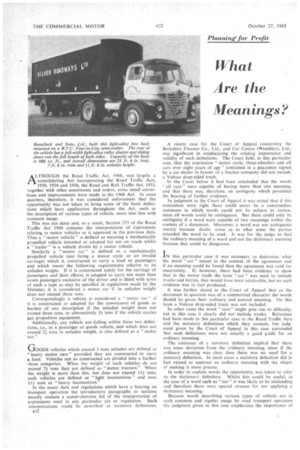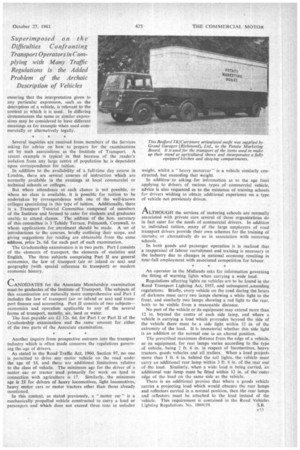Planning for Profit
Page 66

Page 67

If you've noticed an error in this article please click here to report it so we can fix it.
What Are the Meanings?
Superimposed on the Difficulties Confronting Transport Operators in Complying with Many Traffic Regulations is the Added Problem of the Archaic Description of Vehicles
A:THOUGH the Road Traffic Act, 1960, was largely a consolidating Act incorporating the Road Traffic Acts, 1930, 1934 and 1956, the Road and Rail Traffic Act, 1933, together with other enactments and orders, some small corrections and improvements were made in the 1960 Act. In some quarters, therefore, it was considered unfortunate that the opportunity was not taken to bring some of the basic definitions which have application throughout the Act, such as the description of various types of vehicle, more into line with common usage.
This was not done and, as a result, Section 253 of the Road Traffic Act 1960 contains the interpretation of expressions relating to motor vehicles as it appeared in the previous Acts. Thus a "motor vehicle" is defined as meaning a mechanically propelled vehicle intended or adapted for use on roads whilst a " trailer" is a vehicle drawn by a motor vehicle.
Similarly a "motor car" is defined as a mechanically propelled vehicle (not being a motor cycle or an invalid carriage) which is constructed to carry a load or passengers and which meets the following requirements relative to its unladen weight. If it is constructed solely for the carriage of passengers and their effects, is adapted to carry not more than seven passengers exclusive of the driver and is fitted with tyres of such a type as may be specified in regulations made by the Minister, it is considered a motor car if its unladen weight does not exceed three tons.
Correspondingly a vehicle is considered a "motor car" if it is constructed or adapted for the conveyance of goods or burden of any description if the unladen weight does not exceed three tons, or alternatively 33 tons if the vehicle carries gas propulsion equipment. Additionally, any vehicle not falling within these two definitions, i.e.. as a passenger or goods vehicle, and which does not exceed 23 tons in unladen weight, is also defined as a " motor car."
GOODS vehicles which exceed 3 tons unladen arc defined as "heavy motor cars" provided they are constructed to carry a load. Vehicles not so constructed are divided into a further three categories. When the weight of such vehicles do not exceed 7+ tons they are defined as "motor tractors." When the weight is more than this, but does not exceed 113 tons, such vehicles are defined as "light locomotives" and over 113 tons as "heavy locomotives."
In the many Acts and regulations which have a bearing on transport operation the introductory paragraphs or sections usually contain a comprehensive list of the interpretation of expressions used in any particular act or regulation. Such interpretations could be described as statutory definitions.
B32 A recent case for the Court of Appeal concerning the Berkshire Finance Co.. Ltd., and Car Centre (Wembley). Ltd., was significant in emphasizing the relative importance and validity of such definitions. The Court held, in this particular case, that the expression "motor cycle, three-wheelers and all cars over eight years of age" contained in a guarantee signed by a car dealer in favour of a finance company did not include a Vulcan drop-sided truck.
In the Court below it had been concluded that the words all cars" were capable of having more than one meaning. and that there was, therefore, an ambiguity which permitted the hearing of further evidence.
In judgment in the Court of Appeal it was stated that if this contention were right there could never be a construction summons in which words could not be subject to review, since all words could be ambiguous. But there could only be ambiguity if a word were capable of two meanings within the context of a document. Moreover, a word was not ambiguous merely because doubt arose as to what sense the parties intended the word to be used. It was for the judge to find the ordinary meaning of a word and not the dictionary meaning because that could be dangerous.
IN this particular case it was necessary to determine what the word "car" meant in the context of the agreement and if no meaning could be found then the agreement was void for uncertainty. If, however, there had been evidence to show that in the motor trade the term "car" was used to include trucks and lorries, that would have been admissible, but no such evidence was in fact produced.
It was further stated in the Court of Appeal that as the document in question was of a commercial character the words should be given their ordinary and natural meaning. On this basis a Vulcan drop-sided truck was not included.
In other cases the word "cars" might give rise to difficulty, but in this case it clearly did not include trucks. Reference had been made in this particular case to the Road Traffic Acts and the statutory definitions which they contain, but judgment given by the Court of Appeal in this case contended that such definitions were not usually a good guide for an ordinary meaning.
The existence of a statutory definition implied that there was some deviation from the ordinary meaning, since if the ordinary meaning was clear then there was no need for a statutory definition. In most cases a statutory defiaition did in fact extend or contract an ordinary meaning with the object of making it more precise.
In order to explain words the opportunity was taken to refer to the dictionary definition. Whilst this could be useful, in the case of a word such as "car" it was likely to be misleading and therefore there were special reasons for not applying a dictionary meaning.
Because words describing various types of vehicle are in such common and regular usage by road transport operators the judgment given in this case emphasizes the importance of
Several inquiries are received from members of the Services asking for advice on how to prepare for the• examinations set by such associations as the Institute of Transport. A recent example is typical in that because of the reader's isolation from any large centre of population he is dependent upon correspondence for tuition.
In addition to the availability of a full-time day course in London, there are several courses of instruction which are normally available in the evenings at local commercial or technical schools or colleges.
But where attendance at such classes is not possible, or where no class is available, it is possible for tuition to be undertaken by correspondence with one of the well-known colleges specializing in this type of tuition. Additionally, there is a Transport Tutorial Committee composed of members of the Institute and formed to cater for students and graduates unable to attend classes. The address of the hon. secretary of this. committee is 3 Tehidy Terrace, Falmouth, Cornwall, to whom applications for enrolment should be made. A set of introductions to the courses, briefly outlining their scope, and giving suggestions for reading are obtainable from the same address, price 2.s. 6d, for each part of each examination.
The Graduateship examination is in two parts. Part I consists of the elements of transport, the elements of statistics and English. The three subjects comprising Part H are general economics, the law of transport (air or inland or sea) and geography (with special reference to transport) or modern economic history.
CANDIDATES for the Associate Membership examination must be graduates of the Institute of Transport. The subjects of this examination are naturally more comprehensive and Part I includes the law of transport (air or inland or sea) and transport finance and accounting. Part II consists of two subjects— economics and operation applicable to any of the several forms of transport, namely, air, land or water.
The fees payable are £2 12s. 6d. for Part I or Part II of the Graduateship examination and the same amount for either of the two parts of the Associate examination.
Another inquiry from prospective entrants into the transport industry which is often made concerns the regulations governing the age of drivers.
As stated in the Road Traffic Act, 1960, Section 97, no one is permitted to drive any motor vehicle on the road under the age of 16, and there are additional limitations relative to the class of vehicle. The minimum age for the driver of a motor car or tractor used primarily for work on land in connection with agriculture is 17. Similarly, the minimum age is 21 for drivers of heavy locomotives, light locomotives. heavy motor cars or motor tractors other than those already mentioned.
In this context, as stated previously, a "motor car" is a mechanically propelled vehicle constructed to carry a load or passengers and which does not exceed three tons in unladen weight, whilst a "heavy motorcar" is a vehicle similarly constructed, but exceeding that weight.
In addition to asking for information as to the age limit applying to drivers of various types of commercial vehicle, advice is also requested as to the existence of training schools for drivers wishing to obtain additional experience on a type of vehicle not previously driven.
ALTHOUGH the services of motoring schools are normally associated with private ears several of these organizations do in fact cater for the needs of commercial drivers. In addition to individual tuition, many of the large employers of road transport drivers provide their own schemes for the training of recruits; or alternatively do so in association with motoring schools.
In both goods and passenger operation it is realized that a reappraisal of labour recruitment and training is necessary in the industry due to changes in national economy resulting in near-full employment with associated competition for labour.
An operator in the Midlands asks for information governing the fitting of warning tights when carrying a wide load.
Regulations affecting lights on vehicles are to be found in the Road Transport Lighting Act, 1957, and subsequent,amending regulations. Briefly, every vehicle on the road during the hours of darkness must carry two lamps showing a white light to the front, and similarly two lamps showing a red light to the rear, both to be visible from a reasonable distance.
No part of the vehicle or its equipment may extend more than 12 in. beyond the centre of each side lamp, and where a vehicle is carrying a load which protrudes beyond the side of the vehicle there must be a side light within 12 in. of the extremity of the load. It is immaterial whether this side light is an addition or the normal one in an altered position.
The prescribed maximum distance from the edge of a vehicle, or its equipment, for rear lamps varies according to the type of vehicle, being 2 ft. 6 in. in respect of locotnotives, heavy tractors, goods vehicles and all trailers. When a load projects more than 3 ft. 6 in. behind the tail lights, the vehicle must carry an additional rear lamp within 3 ft. 6 in. of the rear end of the load. Similarly, when a wide load is being carried, an additional rear lamp must be fitted within 12 in. of the outer edge of the load on the same side as the vehicle.
There is an additional proviso that where a goods vehicle carries a projecting load which would obscure the rear lamps and reflectors carried in a normal position, then the rear lamps and reflectors must be attached to the load instead of the vehicle. This requirement is contained in the Road Vehicles
Lighting Regulations No. 1869/59. S.B.




















































































































